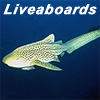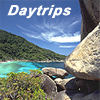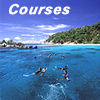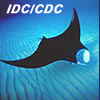Reef Ecology Guide Phuket Thailand - Echinoderms
ECHINODERMS

The phylum Echinodermata consists of 5 main classes - sea stars, brittle stars, sea urchins, sea cucumbers and feather stars. The Latin name echinoderm literally means spiny-skinned in reference to the plate-like calcareous skeleton of these animals.
All echinoderms are characterized by a radial symmetry, which is very obvious in most starfishes. Also common to all echinoderms is a remarkable water vascular system, serving as locomotion. Water is drawn into the system through a sieve plate on the upper surface and conveyed to the arms by a series of canals.
Many echinoderms serve as hosts to a variety of symbiotic or parasitic organisms.
SEA STARS

Starfish are well known for their powers of regeneration. A complete new animal can grow from a small fragment. In some species one of the arms will virtually pull itself away from the body and regenerate.
Sexual reproduction is also evident in this group. Sexes are generally separate. Their eggs get fertilized externally. From the huge amount of released eggs only relatively few of the free-swimming larvae survive.
CROWN-OF-THORNS STARFISH (Acanthaster planci)
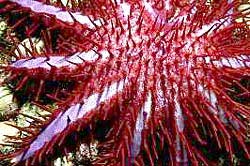 A large species which are about 40 cm in diameter.
A large species which are about 40 cm in diameter.
Feeds on coral polyps and can destroy entire reefs when occurring periodically in big amounts.
It has sharp, toxic spines and wounds can be very painful. Medical attention should be obtained.
BLUE SEA STAR (Linckia laevigata)
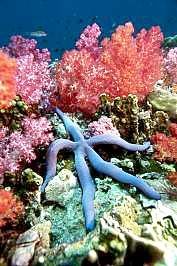 Encountered among algae-covered coral debris and in sea grass beds from shallow water down to 25 m.
Encountered among algae-covered coral debris and in sea grass beds from shallow water down to 25 m.
This species prefers asexual reproduction separating an arm from its body, which converts to a complete animal.
BIG-PLATED SEA STAR (Choriaster granulatus)
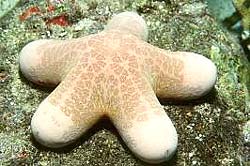 This sea star is sometimes inhabited by a parasitic transparent fish that actually lives within its gut cavity.
This sea star is sometimes inhabited by a parasitic transparent fish that actually lives within its gut cavity.
FEATHER STARS

Feather stars are one of the most visible members of the reef community. They are abundant in areas with strong currents, which provides an abundant supply of planktonic food.
They use special appendages called cirri on the underside of the body to cling to the bottom. They are frequently perched on sponges and tall coral heads in order to get maximum exposure to the passing current. They use the cirri for crawling over the reef and can actually swim by flapping the feathery arms.
They have skin toxins which serve as a deterrent. The bright colors displayed by many feather stars signal distasteful qualities.
FEATHER STAR (Oxycomanthus benetti)
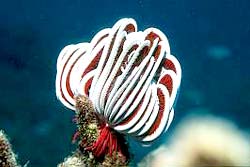 Most frequently encountered feather star with many different colorations.
Most frequently encountered feather star with many different colorations.
Primarily nocturnal in habit, it is not unusual to see them in daytime.
They are opportunistic; feeding when currents are optimum.
SEA URCHINS

Sea urchins are generally nocturnal. They spend the day tightly wedged under rocks or in crevices. However, the diadema sea urchin sometimes forms aggregations in exposed situations. In spite of their sharp spines, urchins are fair game for some fishes, particularly trigger fishes and puffers.
Many sea urchins are algal grazers, but others feed on a variety of organisms, especially sponges and ascidians. The mouth is centrally located on the underside of the body, equipped with well developed jaws and a set of horny teeth.
Sea urchins are basically hollow shells. Very little space is occupied by the internal organs. During the breeding season, the body cavity is crammed with eggs and sperm, what make them very attractive for fish predators.
Although they should be respected as a potential danger because of their venomous spines, sea urchins are beautiful,fascinating creatures.
DIADEMA SEA URCHIN (Echinothrix diadema)
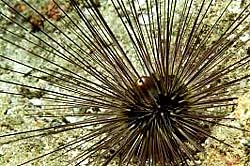 Mainly found on hard substrates, feeding on algae and coral polyps.
Mainly found on hard substrates, feeding on algae and coral polyps.
Its black spines are long, thin, hollow and very fragile (harmful,but not poisonous).
May be locally very abundant as they ar at the Similan Islands.
GLOBE SEA URCHIN (Mespilia globulus)
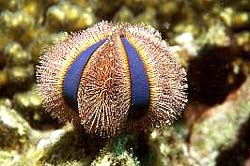 Very colorful member of the sea urchin family.
Very colorful member of the sea urchin family.
Most encountered singly on sandy parts within coral reefs not deeper than 20 m.
SEA CUCUMBERS

At first glance sea cucumbers appear to have little in common with starfishes or sea urchins. Unlike other members of this phylum, they do not have distinct radial symmetry, at least on the outside.
The more or less flexible calcareous skeleton of the echinoderms is reduced to microscopic particles, embedded into the leathery skin. The body is elongate with a head and a tail. This body form evolved in response to their way of life.
Like living conveyor belts they ingest large amounts of sand while slowly crawling over the bottom. The edible, organic material is digested in a tube-like digestive tract. The processed sand is then expelled from the anus, leaving a characteristic trail on the bottom.
Dive Asia - Phuket Thailand
Office Address: 23/6 Karon Rd, Kata Beach, Phuket 83100, Thailand
Phone: +66 (0) 76330598
Visit us at one of our Offices: (Google Map)
Email:
Website: www.diveasia.com
24 Hour Hotline: +66 (0) 818948588








